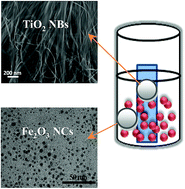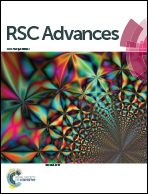Visible-light photocatalytic performances of TiO2 nanobelts decorated with iron oxide nanocrystals†
Abstract
A TiO2–Fe2O3 hetero-nanostructure was fabricated via a three-step method and evaluated for its visible-light photocatalytic performances. TiO2 nanobelts (NBs) were synthesized by controlled hydrothermal oxidation of a Ti sheet while Fe2O3 nanocrystals (NCs) were prepared by forced hydrolysis in polyol. NBs were then decorated with NCs using direct impregnation. The structure, morphology and chemical composition of the resulting hybrids were investigated by X-ray Diffraction (XRD), Field Emission Gun Scanning Electron Microscopy (FEG-SEM), Transmission Electron Microscopy (TEM), X-ray Photoelectron Spectroscopy (XPS), Raman and UV-visible diffuse reflectance spectroscopy. The photocatalytic activity was assessed by following methylene blue photodegradation in an aqueous solution under visible light irradiation and comparing to that of bare TiO2 NBs. The photoelectrochemical properties were determined by measuring their ability to oxidize water under mimetic sunlight irradiation. The significant observed improvement was attributed to sensitization of the wide-gap titania semiconductor by the narrow-gap hematite one, namely faster interfacial charge transfer and wider spectral light absorption.



 Please wait while we load your content...
Please wait while we load your content...